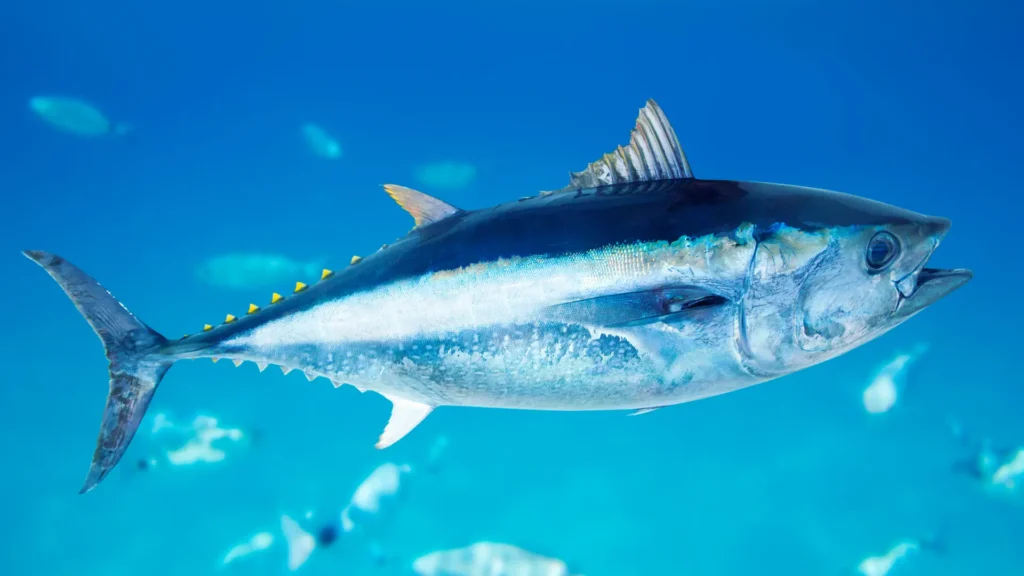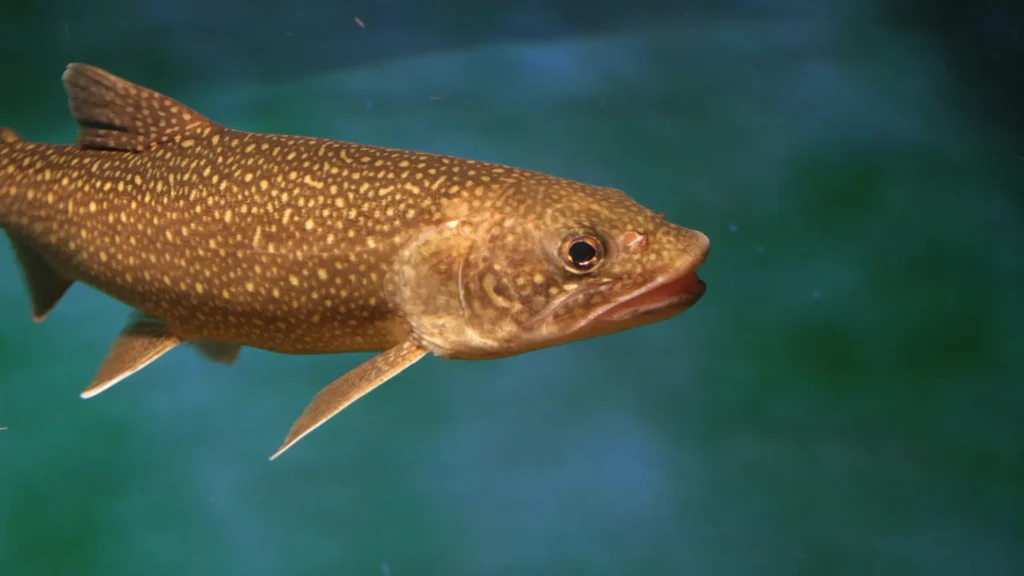If your goal is to catch a massive flathead catfish, you may want to continue reading this blog.
Flathead catfish possess distinct traits and behaviors that set them apart from other catfish species. They belong to the exclusive Pylodictis genus, enhancing their uniqueness. Growing beyond 50 pounds, some remarkable individuals have weighed an astounding 120 pounds. Understanding these characteristics is essential to effectively target them and improve your likelihood of a rewarding catch.
To be successful in your fishing journey, it is essential to first understand what a flathead catfish is.
What is a Flathead Catfish?
Flathead catfish can be identified by their unique brownish yellow color and prominent lower jaw. They stand out from other catfish species as they lack a forked tail, unlike channel catfish. While they thrive in warm waters, anglers in colder regions face a challenge during winter when their metabolism slows down. Nevertheless, their aggression as predators remains a remarkable trait.
When targeting flathead catfish, remember they prefer shallow water near structures like holes, undercuts, and submerged logs. These areas provide hiding spots and feeding grounds. Anglers without boats often prefer night fishing from shore. Those with boats can take advantage of daytime fishing for better mobility and predictable catfish spots.
Pro Tips on Catching a Flathead Catfish
- Right Location
Flathead catfish are versatile and adaptable, thriving in various aquatic environments like deep pools, rivers, lakes, and canals. They are particularly fond of turbid water and slow currents. Their distribution ranges from the lower Great Lakes to the Gulf states, highlighting their adaptability to diverse habitats.
- Best Time
Flathead catfish fishing is most successful in summer. In winter, they move to deeper waters for protection, often hiding among boulders or logs. In these secluded areas, they remain inactive and may accumulate silt on their bodies.
Flathead catfish prefer fishing during lower light conditions like dusk and dawn, as well as on rainy or overcast days. They tend to seek shelter under trees, rocks, or other types of cover during daylight hours.
- Feeding Patterns
Flathead catfish gather in areas with plenty of food, like tailraces of dams. They can be seen feeding near the surface or in shallow water at night. During the day, they retreat to hidden spots like holes or brush piles to rest. It’s worth noting that they prefer fresh food and rarely go after dead or decaying matter.
- Appropriate Bait
For flathead catfish bait, live fish like bluegill, sucker, bullheads, goldfish, shad, and carp are highly recommended. Catching bait locally mimics their natural food source and reduces the risk of introducing foreign species or diseases.
A hand-sized live bluegill is a classic and effective bait for flathead catfish. Bluegill are commonly used due to their availability. Bullheads are larger and can attract massive flatheads. They are also resilient and stay lively on the hook after catching multiple big flatheads.
Goldfish are popular in murky waters due to their bright colors. However, using them may violate fishing regulations, and their escape can lead to reproduction in the wild.
Live bait is the preferred choice for catching flathead catfish, but other options like lures, jigs, cut bait, stink bait, and even fruit-flavored pop-up boilies can also be effective.
Advanced Tactics
- To catch flathead catfish, anglers commonly use a robust rod and reel with a strong fishing line that can handle 50 lbs. pressure.
- Trot lining is another popular method. This method involves the use of a bait to attract the catfish and then capture them with a net.
- Sonar fish finders are essential for successful catfish catching. They use sound waves to locate fish by sending out a signal that bounces off the fish and returns. The signal then continues to the seafloor and bounces back.
- For successful flathead catfishing, use lures that grab their attention from a distance. Vibrant, high-action lures tend to work best.
Live Bait Vs Artificial Lures
- Live Baits
Using live bait to catch catfish is an excellent method for landing large specimens. While live bait can be effective for all catfish species, understanding the nuances of fishing with live bait is crucial, particularly when targeting big flathead catfish.
When fishing with live bait, it’s important to follow local regulations and keep the bait alive. Proper rigging prevents tangling or snagging.
- Artificial Lures
Artificial lures endure longer than live bait, without worrying about their vitality. With a variety of colorful spinners and lifelike swimbaits, anglers can explore and discover the ideal lure for every circumstance.
The Bill Lewis Original Rat-L-Trap® 1/2 oz. Lipless Crankbait is a great artificial lure option. These catfish are attracted to the disturbance they create. Mimicking perch and bluegill, erratic and slow retrieval of artificial crankbaits might entice them.
Which Should You Choose?
When choosing bait for flathead catfishing, consider the fishing conditions. Clear water and skittish fish may require live bait, while bright and noisy artificial lures work well in murkier waters. Check local regulations for any restrictions on using live bait.
Beginners may find live bait easier to use, while lures take practice. Keep both options in your tackle box for versatility on your fishing trip. Remember that both live and artificial baits have their merits, so experiment to find what works best for you.
Drift Fishing and Anchor Fishing Technique
- Drift Fishing
Controlled drifting is a top method for targeting flathead catfish. Anglers can use a precision-controlled trolling motor to strategically navigate and drag baited lines, covering more ground and enticing catfish. This technique allows exploration of various areas and boosts the odds of finding actively feeding fish.
Using a trolling motor mimics live prey and lures flathead catfish. Controlled drifting tests various depths and areas to target catfish at different times. Adjusting the drift speed and direction based on conditions and catfish preferences is vital. Consider wind direction and current flow for better positioning.
Tips for Successful Drift Fishing:
1) Bait MUST always be at the BOTTOM: Succeed in flathead catfishing by using the ‘tapping’ technique. Tap your sinker on the sea bed to reposition your bait and increase your chances of a catch.
2) FEEL your line: Feel the main line between your thumb and index finger as you lower it into the water. You’ll sense a sudden halt when the sinker reaches the seabed. In strong currents, the line will keep flowing, but you’ll notice a gradual slowdown as it reaches the bottom.
3) The boat is NOT stationary: Novice anglers often confuse a snag with a fish pulling on the line. This typically happens when the boat drifts away from the snagged spot. To avoid this, follow the recommended actions to reduce the chances of snagging. If you’re uncertain about the location of your line, reel it up completely and then drop the bait again.
- Anchor Fishing
Anchor fishing, or bottom fishing, is an effective technique to target catfish on the ocean floor. Anglers require proper equipment, including an anchor plummet to secure the line and keep the bait near the fish. A stable fishing rod is essential for handling strikes and ensuring a successful catch.
Tips for Successful Anchor Fishing:
1) Search for the Spot: To search for spots while on an anchored boat, there are a couple of effective techniques:
1. Cast your bait, let it sink, and retrieve slowly with a bouncing motion, covering the boat’s perimeter within your casting range.
2. Drift fishing is an effective technique. Lower your line from the boat until it reaches the seabed. If there are no bites, release more line and let the bait drift farther. Repeat if needed. Reel in to check the bait and repeat the process. This method capitalizes on strong currents to carry the bait away.
Regardless of which method you use, if you get a bite at any point, take note of the casting direction or how much line you had let out previously. This will give you a rough idea of where the fish is feeding, allowing you to repeat the same procedures and present your bait in that specific spot again.
2) Use the Right Rig: To optimize flathead catfishing, consider the current’s strength and select the right rig. In strong currents, use a bottom rig to present bait near the seabed, attracting catfish and enticing them to strike. In weak currents, the paternoster rig is more effective. Allow the bait to float off the seabed and increase visibility to catfish.
The bottom rig offers an advantage over the paternoster rig, placing terminal tackle farther from the bait. Choosing the appropriate rig based on current strength enhances your chances of landing trophy-sized catfish. Remember, use the paternoster rig for weak currents and the bottom rig for strong currents.
3) Don’t do Nothing: To improve your catch rate while flathead catfishing, there are a few effective strategies you can employ. Firstly, consider using various types of sabiki rigs or squid lures to target bait fish and squid. These bait are especially enticing to predatory fish in the area.
It’s also recommended to have both a heavier rod and a lighter setup for catching bait while waiting. Additionally, experimenting with jigging or luring using the lighter setup can yield excellent results. In fact, we’ve found that jigs and lures often outperform traditional bait. Keep testing different fishing techniques to determine what works best in the moment.
Conclusion:
Master pro techniques for flathead catfishing for an exhilarating adventure. Embrace the challenge armed with newfound knowledge and start a rewarding journey. The thrill lies in the strategic pursuit of these elusive giants. Cast your line with confidence, explore diverse techniques, and revel in chasing formidable flathead catfish.
Have you ever tried your luck at catching a flathead catfish? We’re all ears and excited to hear about your experiences in landing these magnificent creatures! Share your stories with us and let’s dive into the world of flathead catfishing together.
Additional Resources:
- Fishing for flathead catfish: https://rivercertified.com/fishing-for-flathead-catfish
- Flathead catfish location and tactics: https://www.in-fisherman.com/editorial/flathead-catfish-today/153334
- 10 Tips for targeting flathead catfish: https://tackletactics.com.au/Tips-Techniques/Saltwater-Estuary/10-Tips-for-Targeting-Flathead
- Fall fishing for flathead catfish: https://realtree.com/fishing/articles/fall-fishing-for-flathead-catfish
Flathead catfish fishing guide: https://norrik.com/freshwater-fish/flathead-catfish/


